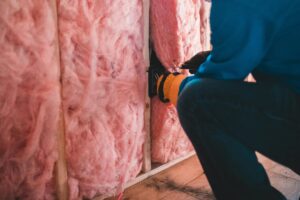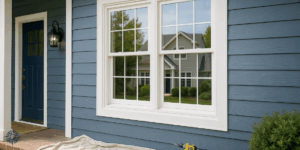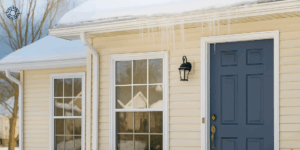Introduction: Gutters Can Last a Lifetime—If You Choose Wisely
When choosing new gutters, most homeowners ask about style, color, or whether to add leaf guards—but the most important decision you’ll make is one you may not expect: material.
Why? Because depending on the material you choose, your gutters can last anywhere from 10 to over 100 years.. While storms and seasonal damage are unpredictable, material durability, cost, and maintenance are fully within your control.
In this guide, we’ll break down the best gutter materials in 2025—including vinyl, aluminum, steel, copper, and zinc—by cost, longevity, curb appeal, and upkeep. We’ll also explore the differences between seamed vs. seamless gutters, the role of gutter coating, and why some homeowners opt for hidden gutters to preserve their exterior aesthetic.
Vinyl Gutters
- Cost: $ (lowest)
- Durability: Low to medium (10–20 years)
- Aesthetics: Simple and color-matched, but prone to fading
- Maintenance: Low upfront, but higher over time due to cracking and sagging
Vinyl gutters are the most budget-friendly option on the market, making them appealing for homeowners looking for an affordable fix or a quick replacement. They are lightweight, easy to install, and available in a range of colors that don’t require painting.
However, vinyl has its limitations. In colder climates, it’s prone to cracking due to temperature fluctuations. In hot, sunny areas, it can become brittle or warp over time. Because vinyl is joined with connectors rather than welded or crimped, leaks can form at the seams.
Vinyl might be a good choice for low-cost installations or temporary solutions, but it’s not ideal for long-term performance in extreme weather zones like the Midwest.
Aluminum Gutters
- Cost: $$
- Durability: Medium to high (20–30 years)
- Aesthetics: Clean and customizable
- Maintenance: Low to moderate; doesn’t rust, but can dent
Aluminum remains the most popular gutter material in 2025—and for good reason. It strikes a great balance between affordability and performance. Aluminum gutters resist rust, are lightweight, and can be formed into seamless systems, which greatly reduces the risk of leaks.
Another benefit? They can be painted any color or purchased pre-finished. This allows aluminum to blend into almost any architectural style. Thicker aluminum grades are also available for areas with frequent storms or hail.
While aluminum is more durable than vinyl, it can dent from falling branches or ladders. Still, for most homeowners, aluminum gutters offer the best all-around value for longevity, style, and cost.
Steel Gutters

- Cost: $$$
- Durability: High (20–40 years with proper maintenance)
- Aesthetics: Sleek and strong
- Maintenance: Moderate; must be coated to resist rust
For homeowners who want strength above all else, steel gutters offer unmatched durability—especially in storm-prone regions. Galvanized or stainless steel can handle heavy rainfall, snow, and impact from debris without buckling or sagging.
However, steel is heavier and more labor-intensive to install, which raises the upfront cost. It’s also prone to rust if not properly coated and maintained, particularly at the joints and seams.
That’s why many steel gutter systems now include a protective gutter coating, such as zinc galvanization or baked-on enamel, which extends lifespan and reduces maintenance.
Steel is a smart choice if you need performance under pressure and are willing to handle some ongoing care.
Copper Gutters
- Cost: $$$$
- Durability: Very high (50–100+ years)
- Aesthetics: Classic, premium appearance with a patina over time
- Maintenance: Low; no painting or rust issues
If you want gutters that make a statement and last a lifetime, copper is the ultimate luxury material. With a lifespan of 50–100+ years, copper requires virtually no maintenance aside from routine cleaning.
Over time, copper develops a rich green patina, adding a sense of heritage and craftsmanship to your home. It’s naturally resistant to corrosion and fungus, and because it’s soldered at the seams, copper gutters are typically seamless by design.
The trade-off? Cost. Copper is significantly more expensive to purchase and install. It’s typically reserved for historic homes, luxury builds, or homeowners who plan to stay long-term and want a once-in-a-lifetime investment.
Zinc Gutters
- Cost: $$$$
- Durability: Very high (40–80 years)
- Aesthetics: Matte silver that ages into a soft patina
- Maintenance: Very low
Like copper, zinc gutters are built for the long haul. They develop a protective patina that resists corrosion and scratches. Zinc is slightly less expensive than copper but offers similar longevity and visual appeal.
Zinc gutters are popular in modern and minimalist architecture, offering a sophisticated, matte finish that weathers beautifully over time. They’re also extremely low maintenance and, like copper, often installed in seamless configurations.
Due to the high price point and specialty installation, zinc is best for high-end homes or homeowners focused on long-term performance with minimal upkeep.
Bonus Considerations: Seamed vs. Seamless, Coatings, and Hidden Gutters

When comparing the best gutter materials, it’s just as important to consider how the system is built and protected. These extra factors affect leak prevention, durability, and maintenance over time.
Seamed vs. Seamless Gutters
Wondering what are seamless gutters? These are gutters fabricated in a continuous roll, custom-fitted to your home without joints along the length. Fewer seams mean fewer places for leaks, clogs, and corrosion to begin.
Seamless gutters are typically made from aluminum, steel, or copper and are cut onsite for a precise fit. While more expensive than seamed vinyl systems, they offer better long-term performance with less maintenance.
Gutter Coating
Gutters exposed to frequent moisture need protection. A gutter coating can be factory-applied (like enamel or powder coating) or applied after installation (sealants and rust inhibitors).
- Aluminum: May be pre-finished or painted
- Steel: Requires galvanized or baked-on coatings
- Copper & Zinc: Naturally weather-resistant, no coating needed
Choosing the right coating extends the gutter’s life and improves its appearance.
Hidden Gutters
Hidden gutters are built into the roofline or behind fascia boards, keeping the system completely out of sight. This style is growing in popularity with modern homes where a clean exterior profile is essential.
However, hidden systems require precise installation and more frequent maintenance, since leaks may be harder to spot. Still, for some homeowners, the sleek aesthetic is worth the extra attention.
Conclusion: Picking the Right Gutter for Your Home and Climate
Choosing the best gutter material isn’t just about price—it’s about lifespan, style, and how much maintenance you’re willing to take on. Here’s a quick summary:
- Vinyl: Budget-friendly, but short lifespan and weather limitations
- Aluminum: Great value, lightweight, rust-resistant, and customizable
- Steel: Tough and durable, but needs protective coating
- Copper: Elegant, expensive, and extremely long-lasting
- Zinc: Durable, low-maintenance, and stylish for modern homes
When it comes to installation, seamless gutters with proper gutter coating offer the best long-term performance, and hidden gutters may be worth considering for certain architectural styles.
At Compass Exteriors, we specialize in helping homeowners choose and install the right gutter system—tailored to their home’s style, their region’s climate, and their long-term maintenance goals.
Contact Compass Exteriors today for a free consultation on gutter repair, replacement, or full system upgrades.







